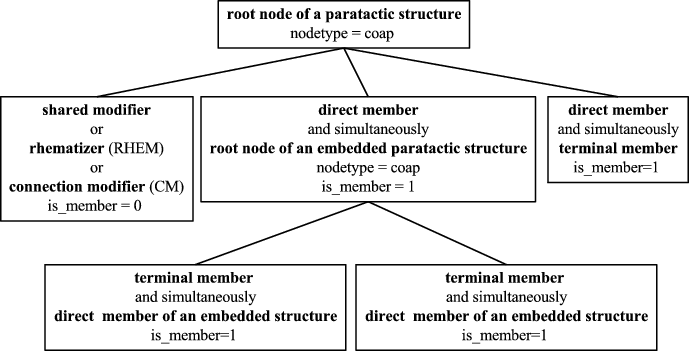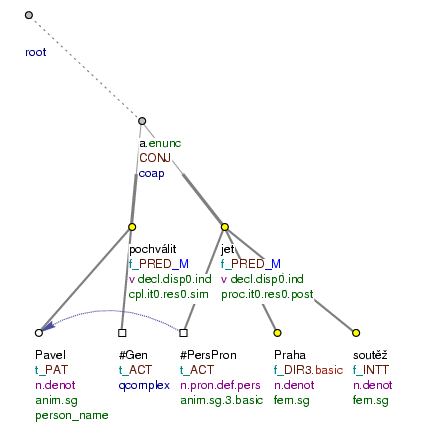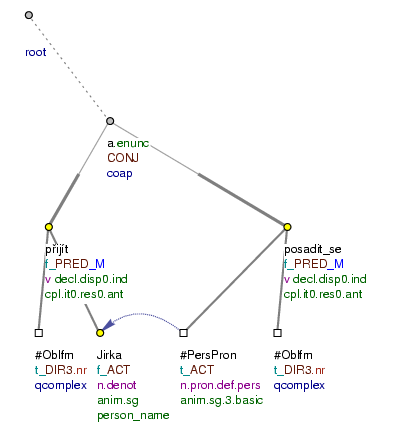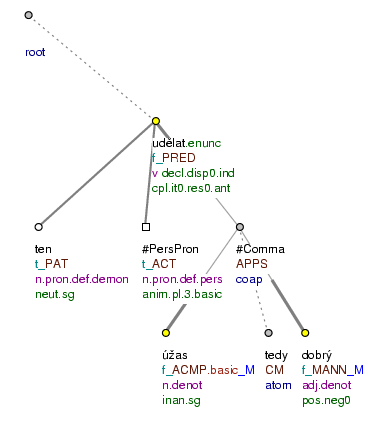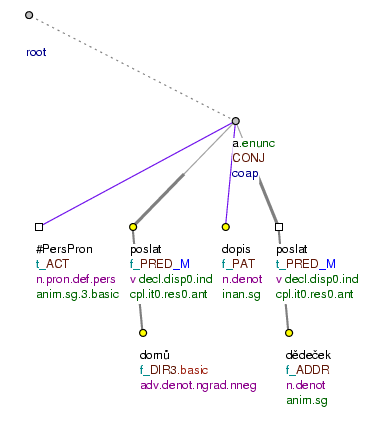At the tectogrammatical level we operate with two-dimensional trees even when representing paratactic connections; hence, we do not establish a special dimension for paratactic connections (however, a consequence is the violation of the dependency principle, see alsoSection 1.2, "Non-dependency edges").
Paratactic structure. Paratactic combination of two or more elements is represented as a paratactic structure in the tectogrammatical tree. Paratactic structure root node is a node representing a coordinating connective or operator. In those rare cases when there is no coordinating connective or a punctuation mark present in the surface structure, the paratactic structure root node is formed by a newly established node with t-lemma #Separ (for more on coordinating connectives and operators see Section 16, "Co-ordinating connectives and operators"). The paratactic structure root node has the nodetype attribute filled with the value coap (see Section 3, "Paratactic structure root nodes").
A paratactic structure root node is a direct daughter of the node that governs the effective root nodes of the connected modifications or clauses.
Nodes representing paratactically connected elements (root nodes of the paratactically connected elements) are direct daughter nodes of the paratactic structure root node.
The root nodes of paratactically connected elements have the value 1 in the is_member attribute. Paratactically connected elements are thus distinguished from the nodes that represent a shared modifier of the paratactic elements. The root node of a shared modifier (see Section 6.1.1, "Shared modifier of paratactically connected elements" below) is also a direct daughter node of the paratactic structure root node but its is_member attribute value is not 1. The values of the is_member attribute are presented in Table 6.3, "Values of the is_member attribute".
Table 6.3. Values of the is_member attribute
1 |
the node is the root node of a paratactically connected element |
0 |
the node is not a root node of a paratactically connected element |
If no value of the is_member attribute is assigned, the assumed value is 0.
A paratactically connected element can be represented by an embedded paratactic structure. In such cases we distinguish between direct and terminal elements of a paratactic structure. By terminal members of a paratactic structure we understand the effective root nodes of paratactically connected modifications or clauses. By direct members of a particular paratactic structure we understand all such direct daughter nodes of the particular paratactic structure which have their is_member attribute filled with the value 1. A direct member of a paratactic structure can be a terminal member at the same time; the root node of an embedded paratactic structure can also be a direct member (if any of the paratactically connected elements is a paratactic connection) but it can never be a terminal member. For more details on embedded paratactic structures see Section 6.1.4, "Embedded paratactic structures".
A direct daughter of a paratactic structure root node (nodetype=coap) can be, then, represented by:
-
effective root node of a paratactically connected modification or clause (a terminal member of a paratactic structure), which has the
is_memberattribute filled with value1. -
root node of an embedded paratactic structure (a direct element of a paratactic structure), which has the
is_memberattribute filled with the value1. -
root node of a shared modifier (modifying the terminal members of a paratactic structure), which has the
is_memberattribute filled with the value0.NB! Shared modifiers can also have the form of a paratactic structure. In such cases the root node of the shared modifier is a paratactic structure root node, however, the value of its
is_memberattribute is0. -
node representing a rhematizer of a shared modifier (see Section 6.4.1, "Rhematizers in paratactic structures"), i.e. a node with the
RHEMfunctor. The value of itsis_memberattribute is also0. -
node representing an expression that modifies the meaning of the paratactic connection (of the connective; see Section 16.1.2, "Conjunction modifiers"), i.e. a node with the
CMfunctor. The value of itsis_memberattribute is also0.
A schematic paratactic structure is presented in Fig. 6.77.
The meaning of the paratactic connection. At the tectogrammatical level, we also specify the meaning of the paratactic connection, i.e. what type of relation there is between the connected elements - it is expressed by the functor assigned to the paratactic structure root node. All functors (and their definitions) which can be assigned to a paratactic structure root node are listed in Section 12, "Functors expressing the relations between the members of paratactic structures".
Principle of representing the structure in the simplest way possible. Parataxis is frequently accompanied by ellipsis (for more on ellipsis see Section 12, "Ellipsis"). Paratactic structures are, in general, represented (in the tree) in the lowest position possible, and a shared modifier is often used (see Section 6.1.1, "Shared modifier of paratactically connected elements" below). Consequently, no newly established nodes for the elided modifications usually need to be added to the tree. We prefer the simplest structure possible, i.e. parataxis of sentence parts is prefered to parataxis of clauses (see Section 6.1.2, "Parataxis of sentence parts, parataxis of clauses and mixed parataxis").
Compare:
-
Jirka potkal a pozdravil Marii (=lit. George met and greeted Mary).
Two inner participants Jirka (=George) and Marie (=Mary) depend as a shared modifier on the coordination of the verbs potkat (=to_meet) and pozdravit (=to_greet). Cf. Fig. 6.78.
Figure 6.78. Representing parataxis
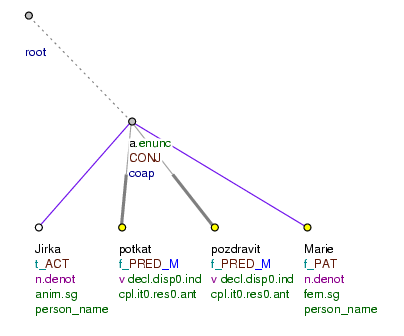
Jirka potkal a pozdravil Marii. (=lit. George met and greeted Mary.)
A shared modifier of paratactically connected elements is such a dependent modifier (also in the form of a clause) that modifies each paratactically connected (terminal) element and that is expressed only once at the surface structure of the sentence.
A shared modifier of a paratactic structure can be any modification (i.e. an expressed or non-expressed argument or adjunct). Optional modifications are represented as shared modifiers only in semantically unambiguous cases (for more details see Section 12.3.1, "Textual ellipsis of a non-obligatory modification in paratactic structures").
Representing a shared modifier in the tectogrammatical tree. The root node of a shared modifier is represented as a direct daughter of the root node of the paratactic structure, the terminal members of which (the effective root node of) the shared modifier really depends on. The root node of the shared modifier differs from the root nodes of paratactically connected elements in its value of the is_member attribute, which is 0.
Cf:
-
Marii jsem viděl a slyšel zpívat. (=lit. Mary (I) - heard and saw sing.)
The Patient Marii (=Mary), the predicative complement zpívat (=to_sing) and the non-expressed Actor are shared modifiers of the coordinated predicates vidět (=to_see) and slyšet (=to_hear). In the tree, the nodes representing these modifications will be represented as direct daughters of the paratactic structure root node, i. e. of the node representing the conjunction a (=and). The value of their
is_memberattribute is0. Cf. Fig. 6.79. -
{
#PersPron.ACT} Tu věc ti nedám, respektive nemohu dát. (=lit. That thing (I) (to) you will_not_give, actually (I) cannot give.)The Patient věc (=thing), the Addressee ti (=you) and the non-expressed Actor are shared modifiers of the predicates in apposition nedat (=not_to_give) and nemoci dát (=cannot_give). In the tree, the nodes representing these modifiers are represented as direct daughter nodes of the root node of the apposition, i.e. of the node which represents the comma. The value of their
is_memberattribute is0. Cf. Fig. 6.80. -
Jirka potkal Marii a pozdravil. (=lit. George met Mary and said_hello.)
The Actor Jirka (=George) is a shared modifier of the coordinated predicates potkat (=to_meet) and pozdravit (=to_say_hello). In the tree, the node representing the Actor is a direct daughter of the root node of the paratactic structure, i.e. of the node representing the conjunction a (=and). The value of its
is_memberattribute is0.The Patient Marie (=Mary) is a shared modifier of both predicates if the meaning is ... and George said hello to Mary, otherwise it is not a shared modifier and it merely depends on the predicate potkat (=to_meet) and the Patient of the predicate pozdravit (=to_say_hello) has the t-lemma
#PersPron(the meaning is, then, that George said hello to someone else who is known from the context), or it has the#Gent-lemma. -
červená čepice a šála (=lit. (a) red cap and scarf)
The free modification červený (=red) will be a shared modifier of both nouns if the meaning is that both the cap and the scarf are red. In the tree, the node representing this free modification is a direct daughter of the root of the paratactic structure, i.e. of the node representing the conjunction a (=and). The value of its
is_memberattribute is0. Cf. Fig. 6.81.If it is not clear from the context whether the scarf is red, the node representing the modification červený (=red) depends on the node representing the noun čepice (=cap) only, i.e. it is not represented as a shared modifier. Cf. Fig. 6.82.
-
Večer jsem uklízel a sestra se dívala na televizi. (=lit. (In)_(the)_evening (I) - was_tidying_up and (the) sister - was_ watching - TV.)
The temporal adjunct večer (=(in)_(the)_evening) represents the shared modifier of the coordinated predicates uklízet (= to_tidy_up) and dívat se (=to_watch). In the tree, the node representing this modification is represented as a direct daughter of the root node of the paratactic structure, i.e. of the node representing the conjunction a (=and). The value of its
is_memberattribtue is0.
NB! A shared modifier can be itself in the form of a paratactic structure. Example:
-
Syna i dceru otec pochválil a matka odměnila. (=lit. (The) son and (the) daughter father praised and mother rewarded.)
The Patient syna a dceru (=(the) son and (the) daughter) is a shared modifier of the coordinated predicates pochválit (=to_praise) and odměnit (=to_reward). The shared modifier will be represented as a paratactic structure. The root node of the shared modifier, i.e. the node representing conjunction i (
is_member=0), will be a direct daughter of the paratactic structure root node, i.e. of the node representing the conjunction a (=and).
NB! A shared modifier can be modified by a rhematizer. The node representing the rhematizer of a shared modifier is represented as a left-side sister of the shared modifier (its root node). It is, therefore, also a direct daughter of the root of the paratactic structure. See also Section 6.4.1, "Rhematizers in paratactic structures".
NB! In embedded structures, the root node of the shared modifier is a direct daughter of the root of the (non)-embedded paratactic structure, the terminal members of which the shared modifier really depends on. See also Section 6.1.4, "Embedded paratactic structures".
NB! The principle of shared modification of paratactically connected elements is closely related to ellipsis. Therefore, see also Section 12.3, "Ellipsis and the principle of shared modification in paratactic structures".
Figure 6.79. Shared modifier of paratactically connected elements
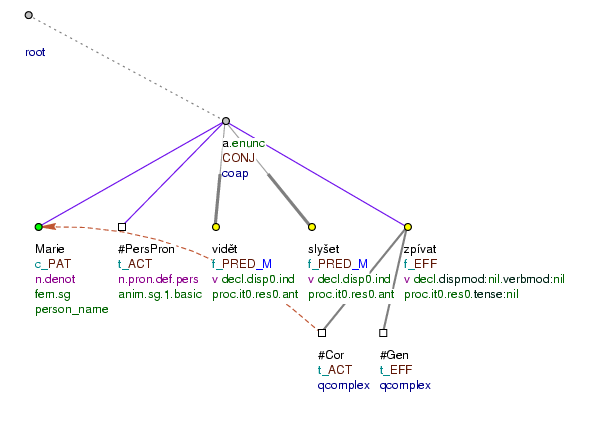
Marii jsem viděl a slyšel zpívat. (=lit. Mary (I) - saw and heard sing.)
Figure 6.80. Shared modifier of paratactically connected elements
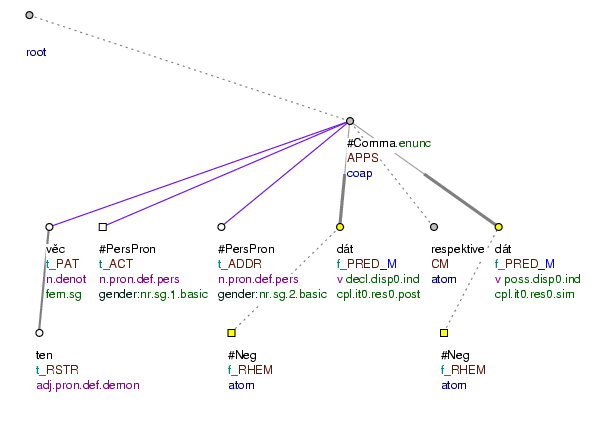
Tu věc ti nedám, respektive nemohu dát. (=lit. That thing (I) (to) you will_not_give, actually (I) cannot give.)
Figure 6.81. Shared modifier of paratactically connected elements
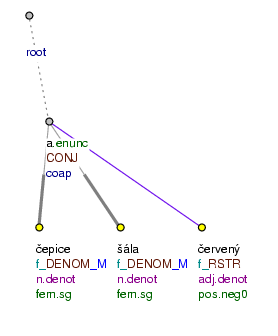
červená čepice a šála (=lit. (a) red cap and scarf)
Figure 6.82. Modification not representing a shared modifier
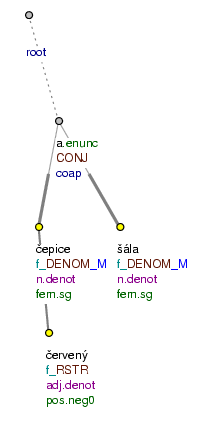
červená čepice a šála (=lit. (a) red cap and scarf)
Cases in which the modification is not a shared modifier. If the modification which could potentially be a shared modifier needs a different value in any attribute with respect to any of the terminal members of the paratactic structure (e.g. the functor or the value of the tfa attribute; i. e. a value different from what is required for the other terminal members), the particular modification is not represented as a shared modifier, but it is added to each element of a paratactic structure in the form of a newly established node with appropriate attributes. Cf.:
-
zakladatel a prezident firmy (=lit. (the) founder and president (of) (the) firm)
=zakladatel {
#PersPron.PAT} a prezident firmy.APP(=lit. (the) founder and president (of) (the) firm)The modification firma (=firm) cannot be a shared modifier of the coordinated nouns, because the noun president requires a modification with the functor
APP, while the noun zakladatel (=founder) requires a modification with the functorPAT. The node representing the noun firma (=firm) is therefore represented as a node with the functorAPPand it depends only on the node representing the noun president (=president). A newly established node with the functorPATand with the t-lemma#PersPronis inserted into the structure as depending on the node representing the noun zakladatel (=founder), and there is a textual coreference relation marked as leading from this node to the node representing the noun firma (=firm). Cf. Fig. 6.84.NB! If the word order were prezident a zakladatel firmy (=lit. (the) president and founder (of) (the) firm) the representation of the structure would be different; see Section 12.3, "Ellipsis and the principle of shared modification in paratactic structures".
-
Pavel bude pochválen a pojede do Prahy na soutěž. (=lit. Pavel will_be_praised and (he) will_go to Prague to (a) competition.)
=Pavel.
PATbude pochválen a {#PersPron.ACT} pojede do Prahy na soutěž.The modification Pavel cannot represent a shared modifier of the predicates pochválit (=to_praise) and jet (=to_go), because concerning the predicate pochválit (=to_praise) it functions as its Patient, while for the predicate jet (=to_go) it is an Actor. Therefore, we establish a new node with the t-lemma substitute
#PersPronand the fuctorACT, and this newly established node will depend on the node representing the predicate jet (=to_go), and it will be connected to the node standing for the Patient Pavel by a coreference relation. Cf. Fig. 6.85. -
Přišel Jirka a posadil se. (=lit. Came George and sat_down -.)
=Přišel Jirka.
ACT[tfa=f] a {#PersPron.ACT[tfa=t]} posadil se.The modification Jirka (=George) cannot be represented as a shared modifier of the predicates přijít (=to_come) and posadit se (=to_sit_down), because Jirka is a contextually non-bound expression in the first clause, while in the second clause it is a contextually bound expression. A newly established node with the t-lemma substitute
#PersPronand with the valuetin the attributetfawill be inserted into the structure as depending on the node representing the predicate posadit se (=to_sit_down) and it will be linked to the Actor Jirka (tfa=f) in the first clause by a coreference relation. Cf. Fig. 6.86.
NB! Cases when something is a shared modifier of all terminal members of a paratactic structure needs to be distinguished from the cases in which a modification modifies only one, or several terminal members. In such cases, the node representing the modification (in fact, the effective root node of this modification) is not a direct daughter of the root of the paratactic structure but it depends on one of the terminal elements. If the modification modifies more terminal members, but not to all of them, it occurs in the form of newly established nodes (the rules are described in Section 12.2, "Ellipsis of the dependent element") as depending on all the elements it modifies. Cf.:
-
Tento stroj se vyráběl u nás, posílal se do zahraničí a tam ho teprve firmy prodávaly do továren. (=lit. This machine - was_produced by us, (it) was_sent - - abroad and there it only firms sold to factories.)
The modification stroj (=machine) is not represented as a shared modifier of all the three predicates; it is the Patient of the predicate vyrábět (=to_produce) and posílat (=to_send), but not of the predicate prodávat (=to_sell). In the tree, the node representing the modification stroj (=machine) therefore depends on the first predicate as its Patient; the predicate posílat (=to_send) has a newly established node with the t-lemma substitute
#PersPronin its Patient position (this newly established node is linked by a coreference relation to the expressed Patient stroj (=machine)). Similarly, the general Actor of the first two predicates is not represented as a shared modifier. Cf. Fig. 6.83.
Figure 6.83. Modification not representing a shared modifier
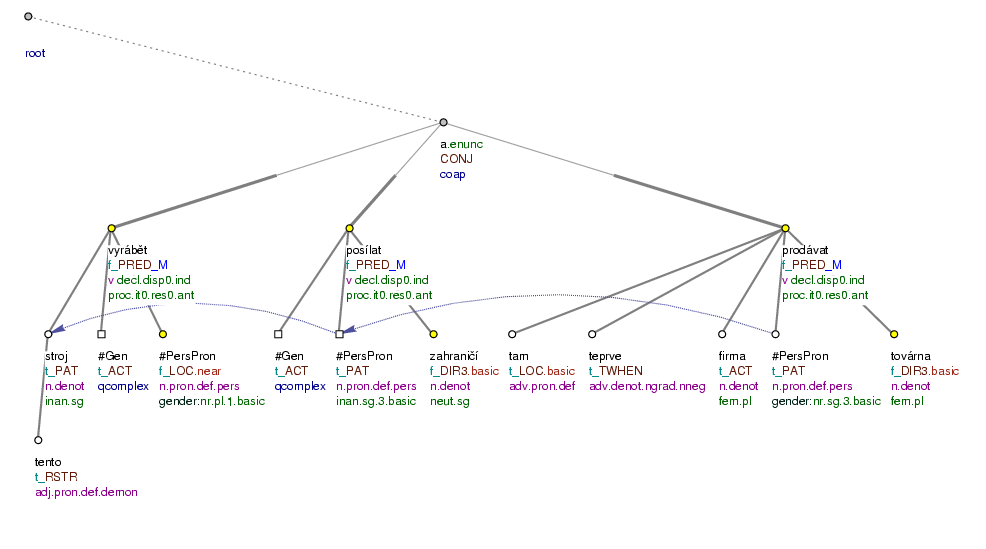
Tento stroj se vyráběl u nás, posílal se do zahraničí a tam ho teprve firmy prodávaly do továren. (=lit. This machine - was_produced by us, (it) was_sent - - abroad and there it only firms sold to factories.)
Figure 6.84. Modification not representing a shared modifier
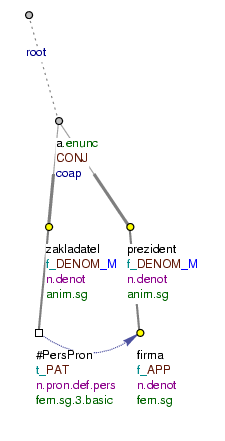
zakladatel a prezident firmy (=lit. (the) founder and president (of) (the) firm)
When annotating paratactic structures, it is necessary to distinguish between parataxis of sentence parts (constituents), parataxis of clauses and mixed parataxis:
-
parataxis of sentence parts.
Parataxis of sentence parts involves paratactic connections of two or more modifications, or clauses the effective root nodes of which are not verbs.
With parataxis of sentence parts, the terminal members of the paratactic structure are not verbs.
Examples:
Hlavní podezřelý.
ACT[is_member=1] , ředitel.ACT[is_member=1] zoologické zahrady zůstává na svobodě. [#Comma.APPS] (=lit. (The) main suspect, (the) director (of) (the) zoological garden remains at large.)Je prezidentem jen díky mým taktickým.
RSTR[is_member=1] a.CONJdiplomatickým.RSTR[is_member=1] schopnostem. (=lit. (He) is president only due_to my tactical and diplomatic skills.)Špičková cena.
DENOM[is_member=1] a.CONJšpičkový výkon.DENOM[is_member=1] (=lit. (a) top price and (a) first-rate performance) -
parataxis of clauses.
Parataxis of clauses stands for paratactic connections of two or more modifications, or clauses the effective root nodes of which are verbs. These are mainly paratactic connections of verbal clauses (see Section 4.3, "Connecting verbal and non-verbal clauses").
With clausal parataxis, the terminal members of the paratactic structure are verbs.
Examples:
Vystoupím.
PRED[is_member=1] na vánočním koncertě, objíždím.PRED[is_member=1] mimopražské premiéry našeho filmu a.CONJtěším.PRED[is_member=1] se na Vánoce. (=lit. (I) will_appear in (the) Christmas concert, (I) travel_around (the) outside_Prague premieres (of) our film and (I) look_forward - to Christmas.)Vladimír Zubov obdivuje.
PRED[is_member=1] herce a.CONJportrétuje.PRED[is_member=1] je podle fotografií. (=lit. Vladimir Zubov admires actors and portrays them according_to (their) photographs.)Jirka potkal.
PRED[is_member=1] a.CONJpozdravil.PRED[is_member=1] Marii. (=lit. George met and greeted Mary.)Lékař včera oznámil, že stav pacienta je.
EFF[is_member=1] stabilizovaný, že přímé ohrožení života je.EFF[is_member=1] zažehnané a.CONJtrvalé následky jsou.EFF[is_member=1] vyloučeny. (=lit. (The) doctor yesterday announced that (the) state (of) patient is stable, that direct danger (of) life are averted and continual effects are eliminated.)Chystáme se nejen stavět.
PAT[is_member=1] domy, ale.GRADtaké rozšiřovat.PAT[is_member=1] ulice. (=lit. (We) are_planning - not_only (to) build houses but also (to) expand streets) -
mixed parataxis.
Mixed parataxis concerns paratactic connections of two or more elements in which the effective root node of at least one of the connected elements is expressed by a verb and the effective root node of at least one of them is not expressed by a verb.
With mixed parataxis, at least one terminal member of the paratactic structure is a verb and at least one terminal member is not a verb.
Examples:
Téma.
DENOM[is_member=1] : Co právě dělám.PRED[is_member=1] [#Colon.APPS] (=lit. Topic: What right_now (I) am_doing)O zajímavých místech.
PAT[is_member=1] mimo Prahu, jako.APPSje.PAT[is_member=1] třeba Litomyšl, Kutná Hora nebo Český Krumlov, zahraniční turisti většinou nevědí. (=lit. About interesting places outside Praha such_as - for instance Litomyšl, Kutná Hora, or Český Krumlov foreign tourists usually do_not_know.)
Paratactic connection of elements expressing mathematical operations and intervals is always a case of parataxis of sentence parts (this type of paratactic connection is not discussed in detail in this section).
In accordance with the principle of the simplest structure possible (see Section 6.1, "Representing parataxis in a tectogrammatical tree"), parataxis of sentence parts is always preferred to clausal parataxis. Nevertheless, it is not always possible to represent several potentially paratactic modifications in the form of parataxis of sentence parts. In all cases in which potentially paratactically connected modifications do not meet the conditions for being considered parataxis of sentence parts, we interpret the structure in terms of clausal parataxis, i.e. the nodes representing the governing predicates of each of these modifications are added into the tectogrammatical tree by means of newly established nodes with the t-lemma substitute #EmpVerb or with the help of copied nodes (the rules are described in Section 12.1.1, "Ellipsis of the governing verb").
Conditions for interpreting the structure in terms of parataxis of sentence parts. The following conditions have to be met in order to interpret the structure in terms of parataxis of sentence parts:
-
agreement in fuction,
-
agreement in form.
Agreement in function means primarily agreement in functors of the terminal members of the paratactic structure. Nevertheless, modifications with different functors can also be connected in coordination or apposition. However, these are always functors of a particular semantic group (e.g. modifications with different temporal functors). Therefore, there are only incomplete rules as to the possible functors of the terminal members of paratactic structures (see Section 6.1.3, "Functors of the terminal members of a paratactic structure").
!!! It is assumed that it is possible to list all combinations of functors that can cooccur in coordination or aposition. Such a list, however, has not been made yet.
Agreement in form is not obligatory; it is the agreement in function that is decisive.
It is not possible to represent potentially paratactically connected modifications as parataxis of sentence parts in those cases in which there are rhematizers or modifications modifying an omitted predicate cooccuring with some (but not all) of the connected elements. Cf.:
-
Přišel Petr a asi i Pavel. (=lit. Came Petr and perhaps also Pavel.)
=Přišel Petr a asi přišel i Pavel. (=lit. Came Petr and perhaps came also Pavel.)
The Actors Petr and Pavel cannot be represented as parataxis of sentence parts; the expression asi (=perhaps) modifies a non-expressed (elided) predicate. What is true for Petr, is not true for Pavel. Therefore, we interpret the structure in terms of clausal parataxis. Cf. Fig. 6.87.
-
Navštívíme hrad, zámek a možná i jeskyni. (=lit. (We) shall_visit (a) castle, (a) manor, and perhaps also (a) cave.)
=Navštívíme hrad, zámek a možná navštívíme i jeskyni. (=lit. (We) shall_visit (a) castle, (a) manor, and perhaps (we) shall_visit also (a) cave.)
The Patients hrad (=castle), zámek (=manor) and jeskyně (=cave) cannot be represented in the form of coordination of sentence parts - there is the expression možná (=perhaps), modifying a non-expressed (elided) predicate. What applies to the castle and manor, does not apply to the cave. Therefore, only the Patients hrad (=castle) and zámek (=manor) are interpreted as members of parataxis of sentence parts, the Patient jeskyně (=cave) depends on a newly established node representing the predicate navštívit (=to_visit), which is in coordination with the expressed predicate. Cf. Fig. 6.88.
When analyzing cases of parataxis of sentence parts and clauses (possibly with an elided verb) with expressions that can be considered either rhematizers, or conjunction modifiers (see Section 6.1.3, "Homonymy: rhematizer - conjunction modifier"), it is the word order position of the homonynous expression what matters:
-
If the homonymous expression occurs directly after the connective in the surface structure, it is taken to be a conjunction modifier and the paratactic structure is analyzed as parataxis of sentence parts. Compare:
-
Přišel Petr a taky Pavel. (=lit. Came Petr and also Pavel.)
In the tree, Petr and Pavel will be represented in terms of parataxis of sentence parts. The node representing the expression taky (=also) is a conjunction modifier (
functor=CM). -
Přišel Petr, ale ne Pavel. (=lit. Came Petr but not Pavel.)
In the tree, Petr and Pavel will be represented in terms of parataxis of sentence parts. The node representing the particle ne (=not) is a conjunction modifier (
functor=CM). For annotation rules of the particles ano (=yes), ne (=no) and nikoli (=not) see alsoSection 13, "Expressions of negation and affirmation".
For the annotation rules concerning conjunction modifiers see Section 16.1.2, "Conjunction modifiers".
-
-
If the homonymous expression occurs in the position of (elided) verb in the surface structure, it is considered a rhematizer, and the paratactic structure is analyzed in terms of clausal parataxis. Compare:
-
Přišel Petr a Pavel taky. (=lit. Came Petr and Pavel too.)
=Přišel Petr a Pavel přišel taky. (=lit. Came Petr and Pavel came too.)
In the tree, the structure is represented as a clausal coordination. The node representing the expression taky (=too) is a rhematizer (
functor=RHEM). -
Přišel Petr, ale Pavel ne. (=lit. Came Petr but Pavel not)
=Přišel Petr, ale Pavel nepřišel. (=lit. Came Petr but Pavel did_not_come.)
Therefore, in the tree, the structure is represented as a clausal coordination. The node representing the particle ne is a rhematizer (
functor=RHEM). For the annotation rules for constructions with the particles ano (=yes), ne (=not) and nikoli (=not) see alsoSection 13, "Expressions of negation and affirmation".
For the annotation rules for rhematizers see Section 6, "Rhematizers".
-
Figure 6.87. Parataxis of clauses
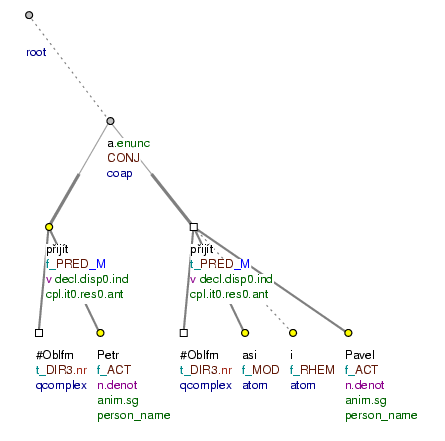
Přišel Petr a asi i Pavel. (=lit. Came Petr and perhaps also Pavel.)
Figure 6.88. Parataxis of clauses
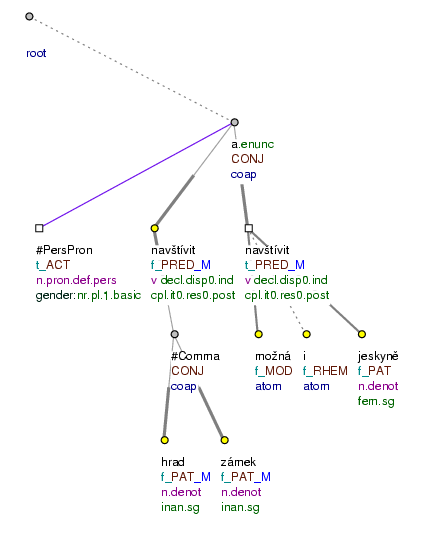
Navštívíme hrad, zámek a možná i jeskyni. (=lit. (We) shall_visit (a) castle, (a) manor and perhaps also (a) cave.)
Mixed parataxis. There are especially two cases that are analyzed in terms of mixed parataxis:
-
paratactic connection of an independent verbal clause and an independent nominative clause.
Example:
Poznámka.
DENOM[is_member=1] : Více informací najdete.PRED[is_member=1] na straně 56. [#Colon.APPS] (=lit. Note: More information (you) will_find on page 56.)For more on connecting verbal and non-verbal clauses see also Section 4.3, "Connecting verbal and non-verbal clauses".
-
Paratactic connection of a dependent modification and a dependent verbal clause.
Examples:
Oznámil svou prohru.
EFF[is_member=1] a.CONJže se rozvádí.EFF[is_member=1] (=lit. (He) announced his defeat and that (he) was_getting_divorced.)Získal pět bodů.
PAT[is_member=1] , což je.PAT[is_member=1] minimum. (=lit. (He) got five points, which is (the) minimum.) [#Comma.APPS]O zajímavých místech.
PAT[is_member=1] mimo Prahu, jako.APPSje.PAT[is_member=1] třeba Litomyšl, Kutná Hora nebo Český Krumlov, zahraniční turisti většinou nevědí. (=lit. About interesting places outside Prague such_as - for instance Litomyšl, Kutná Hora, or Český Krumlov foreign tourists usually do_not_know.)
Appositions with the conjunction jako (=such_as) form a frequent case of mixed paratactic structures (see Section 6.2.1.3, "Apposition with the conjunction "jako"").
For more on constructions with the relative pronoun což (=which) see Section 5.4.1.1, "Constructions with the connectives "což", "přičemž", "načež", "pročež", "začež", "aniž"".
Particularly those elements that have the same function (functor) enter into paratactic structures. However, the functors of the terminal members paratactic structures can also differ, in which the following holds:
-
functors of operators expressing mathematical operations and intervals are always identical.
-
functors of the terminal elements in cases of clausal parataxis are always identical
-
in cases of parataxis of sentence parts, the terminal elements can have different functors only in the case of coordination or apposition of non-obligatory free modifications. This is mainly the case when adverbs and prepositional phrases are in coordination or apposition.
Examples:
pracovní doba osmihodinová.
RSTR[is_member=1] a.CONJbez přestávky.ACMP[is_member=1] (=lit. working hours eight-hour and without (a) break) Fig. 6.89čistá.
RSTR[is_member=1] pracovní doba, tj..APPSbez přestávky.ACMP[is_member=1] (=lit. net working hours, i.e. without (a) break) Fig. 6.90Udělali to s úžasem.
ACMP[is_member=1] , tedy dobře.MANN[is_member=1] [#Comma.APPS] (=lit. (They) did it with astonishment therefore well.) Fig. 6.91NB! It is impossible for two valency modifications (even if they have the same functor) to be represented as constituent coordination or apposition (parataxis of sentence parts) if they belong to two different valency frames. In such case, the paratactic structure needs to be represented as clausal coordination or apposition. Cf.:
-
Poslal dopis domů.
DIR3a dědečkovi.ADDR(=lit. (He) sent (a) letter home and (to) (the) grandfather.)=Poslal dopis domů a poslal dopis dědečkovi. (=lit. (He) sent (a) letter home and (he) sent (a) letter (to) (the) grandfather.)
The verb poslat (=to_send) has two valency frames, one of them requires an Addressee while the other requires a modification with a directional meaning; the construction will be represented as clausal parataxis. Cf. Fig. 6.92.
NB! It is also impossible for an argument and adjunct to be connected in constituent coordination or apposition. These cases are also represented as clausal coordination or apposition with the ellipsis of the governing verb.
-
-
In the case of mixed parataxis of a non-verbal modification and a dependent verbal clause, the value of the functor of the effective root node of the non-verbal member is determined on the basis of the node's relation to its governing node. The effective root node of the verbal clause has always the same functor as the terminal element not representing a verb.
In the case of mixed parataxis of a non-dependent verbal clause and a non-dependent nominative clause, the functors of the terminal members of the paratactic structure are determined with the help of the rules described in Section 4, "Verbal and non-verbal clauses".
Figure 6.89. Functors of the terminal members of a paratactic structure
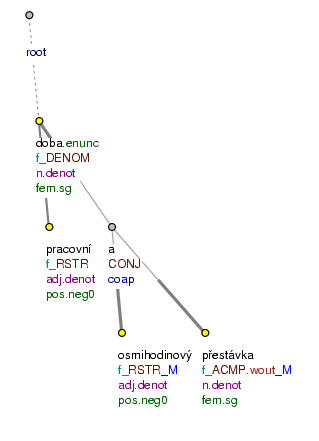
pracovní doba osmihodinová a bez přestávky (=lit. working hours eight-hour and without (a) break)
Figure 6.90. Functors of the terminal members of a paratactic structure
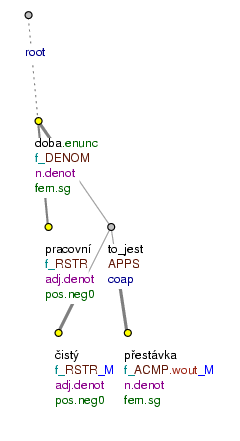
čistá pracovní doba, tj. bez přestávky (=lit. net working hours, i.e. without (a) break)
Paratactic structures can also be embedded: an entire paratactic structure can be a member of another paratactic structure.
In such a case, a direct daughter of a paratactic structure can be a root node of another (i.e. the embedded) paratactic structure. The root node of an embedded structure has the attribute is_member filled with the value 1.
Compare:
-
Akela, náčelník zdejších skautů, a Medvěd, náčelník spřáteleného střediska, zasedli k táborovému ohni. (=lit. Akela, (a) chieftain (of) local scouts, and Medvěd, (a) chieftain (of) (a) befriended group sat_down to (a) campfire -.)
=coordination of two appositions.
The direct daughters of the root node of the paratactic structure (i.e. of the node representing the conjunction a (=and)) are the root nodes of the embedded appositional structures (i.e. the nodes representing the commas). The value of their
is_memberattribute is1. Cf. Fig. 6.93. -
Stroj funguje, ale ne optimálně, a proto ho musíme buď opravit, nebo koupit nový. (=lit. (The) machine works but not optimally and therefore it (we) must either mend or buy (a) new (one).)
=coordination of two embedded coordinations.
The direct daughters of the root of the (non-embedded) paratactic structure (i.e. of the node representing the conjunction a (=and)) are the root nodes of the embedded paratactic structures (i.e. the nodes representing the conjuctions ale (=but) and nebo (=or)). The value of their
is_memberattribute is1. Cf. Fig. 6.94.
Shared modifier with embedded paratactic structures. A shared modifier modifies all terminal members of the relevant (modified) paratactic structure. Hence, it also modifies the terminal members of all embedded paratactic structures.
Therefore, it is always necessary to decide which root node of which paratactic structure is the appropriate mother of the shared modifier, i.e. which terminal members of which embedded paratactic structures are really modified. Cf.:
-
Petr celý den pracoval na své disertaci a připravoval se na zkoušku z angličtiny, ale večer už nedělal nic. (=lit. Petr all day was_working on his thesis and (he) was_studying - for (the) exam in English but in_the_evening already (he) was_not_doing anything.)
The last clause is coordinated with the coordination of the first two clauses. The Actor Petr is a shared modifier of all the three governing predicates; therefore, it is represented as a direct daughter node of the conjunction ale (=but). Cf. Fig. 6.95.
-
Petr celý den pracoval na své disertaci a připravoval se na zkoušku z angličtiny, zato Honza nedělal nic. (=lit. Petr all day was_working on his thesis and (he) was_studying - for (the) exam in English while Honza was_not_doing anything.)
The last clause is coordinated with the coordination of the first two clauses. The Actor Petr is a shared modifier only of the governing predicates in the embedded structure. Therefore, it is represente as a direct daughter of the node for the conjunction a (=and). Cf. Fig. 6.96.
Shared modifiers can often indicate levels within paratactic structures. However, this is not crucial. For example, in the sentence Tento stroj se vyráběl u nás, posílal se do zahraničí a tam ho teprve firmy prodávaly do továren (=lit. This machine - was_produced by us, (it) was_sent - (to) abroad and there it only firms sold to factories.), discussed above (see Section 6.1.1, "Shared modifier of paratactically connected elements"; cf. Fig. 6.83 ), no such levels are found.
Figure 6.93. Embedded paratactic structures
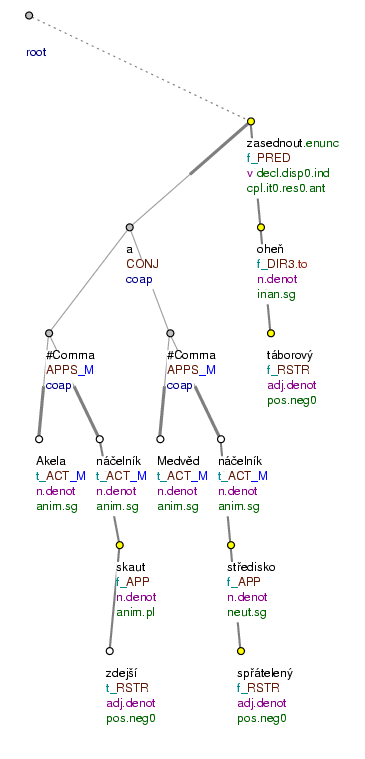
Akela, náčelník zdejších skautů, a Medvěd, náčelník spřáteleného střediska, zasedli k táborovému ohni. (=lit. Akela, (a) chieftain (of) local scouts, and Medvěd, (a) chieftain (of) (a) befriended group sat_down to (a) campfire -.)
Figure 6.94. Embedded paratactic structures
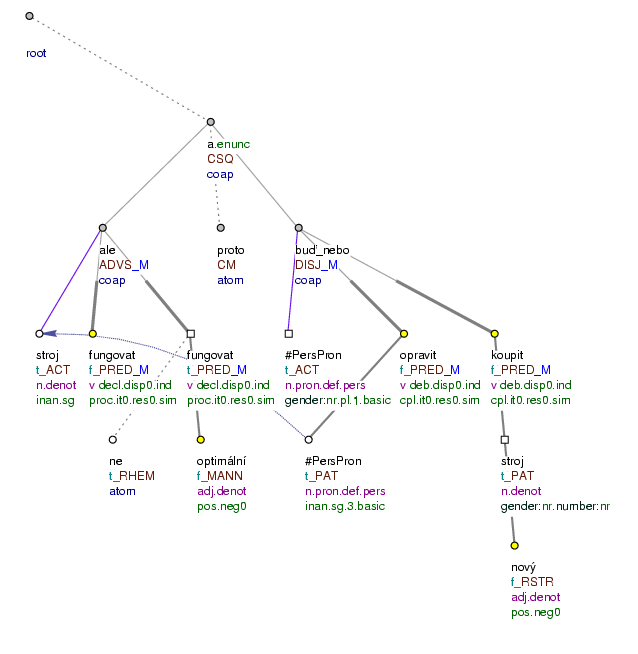
Stroj funguje, ale ne optimálně, a proto ho musíme buď opravit, nebo koupit nový. (=lit. (The) machine works but not optimally and therefore it (we) must either mend or buy (a) new (one).)
Figure 6.95. Shared modifiers with embedded paratactic structures
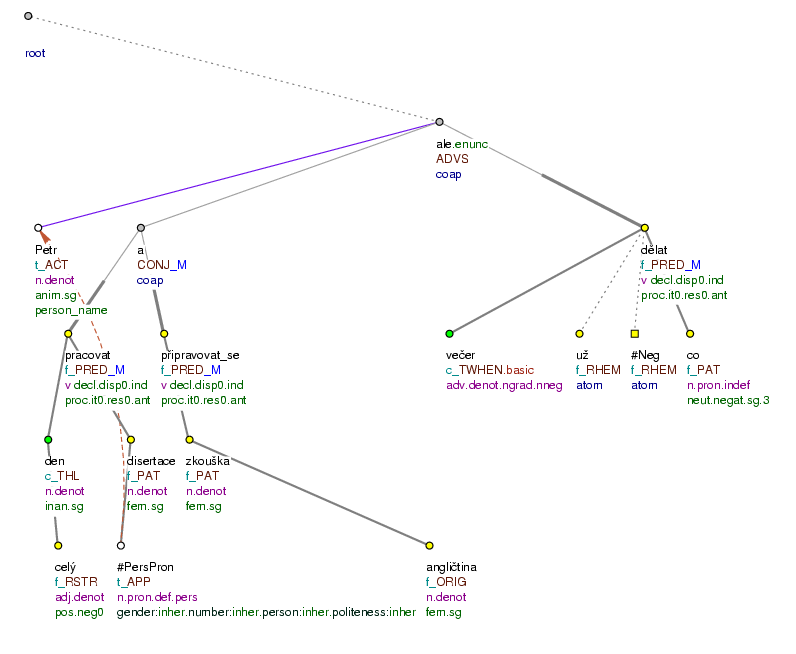
Petr celý den pracoval na své disertaci a připravoval se na zkoušku z angličtiny, ale večer už nedělal nic. (=lit. Petr all day was_working on his thesis and (he) was_studying - for (the) exam in English but in_the_evening already (he) was_not_doing anything.)
Figure 6.96. Shared modifiers with embedded paratactic structures
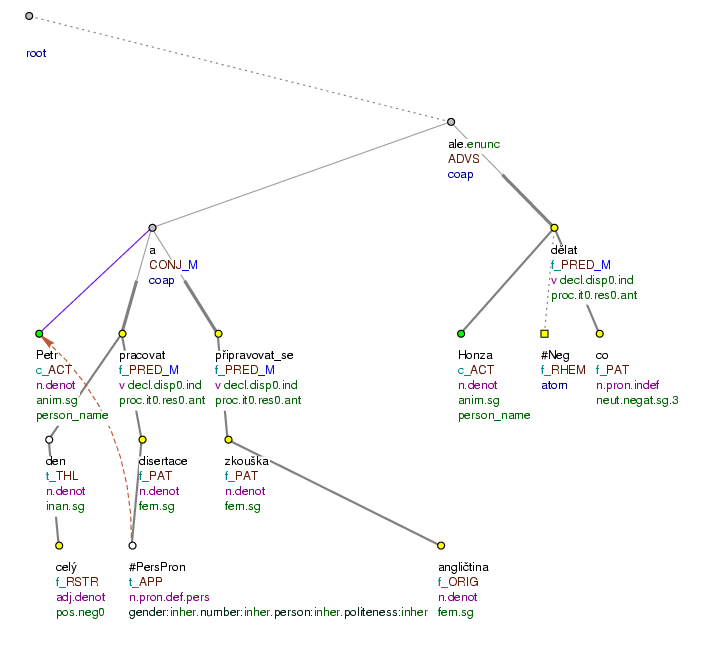
Petr celý den pracoval na své disertaci a připravoval se na zkoušku z angličtiny, ale Honza nedělal nic. (=lit. Petr all day was_working on his thesis and (he) was_studying - for (the) exam in English while Honza was_not_doing anything.)
